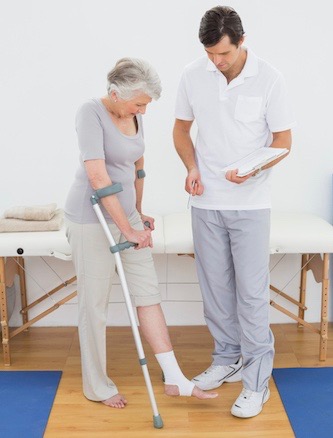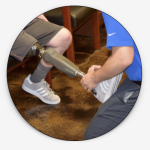YOUR PATHWAY BACK TO MOBILITY
Knowing what to expect can make a significant positive difference in any amputation. Being prepared has proven to speed recovery and expedite the rehabilitation process. Here you can learn the steps behind establishing your team, get informed about the procedure, post-surgery care and gather resources to aid in the pursuit of what’s most important to you. Deciding to go forward with elective amputation is never easy, but there are many things you can do to prepare mentally and physically for surgery. Having a plan is critical to reaching your goals. Evergreen has created a Pathway Back To Mobility for individuals considering amputation or with a current amputation. Not every individual follows the same path, but we can help you overcome barriers and better prepare for what’s to come.
Step One: Select Your Team

Choose a team that has experience working with amputees. Research the type of amputation you are having. Your body will heal faster if you quit smoking, manage your blood sugars and reduce your weight before surgery. Getting your surgical and rehabilitation team in place before surgery will help you feel more comfortable and be better prepared.
Meet with your Prosthetist before surgery so he or she can answer any questions you might have. Discuss what activities are important to you and determine your post-surgery goals. You will be seeing your team a lot in the coming months so developing a good relationship is key to your success and rehabilitation. If you can, carefully choose a Prosthetist, physical therapist, primary care doctor and a specialized surgeon to provide you with a complete care plan, as they work together to help you reach your goals.
Step Two: What to Bring for Your Surgery
When preparing for your stay at the hospital, there are a few items that should not be forgotten for comfort and function. Everyone’s list is a little different but here are some items that have been recommended by other individuals with amputations:
1. A pair of shorts – A pair of shorts offers comfort, function and obviously easy access to lower limbs.
2. Shoe for sound limb – Your rehab team will want to get started soon after surgery, so make sure you bring a comfortable shoe for support.
3. Portable electronic devices and chargers – Entertainment and a connection to the outside world can be a welcomed in your free time.
4. Reading material – Have a good book or magazine? Bring along some reading material to relax your mind and wind down after hard work.
5. Personal pillow/blanket – Bring some comforts of home to help in your recovery and increase your comfort, like your blanket or pillow.
6. Notepad and pen – You will be receiving a lot of new information and contacts. Be prepared by bringing your own pen and notepad.
7. Friend and family contact list – Bring a list of your support team’s contact information in case you need to reach any of them.
8. Clean undergarments – Your hospital stay may be an undetermined length and you should prepare for anything. A set of clean undergarments can keep you fresh and prepared to tackle rehab activities head-on.
Step Three: What to Expect After Surgery
Each Physician may have a different approach to post-operative care. Generally you can expect to begin rehabilitation immediately after surgery. Usually, the limb is very bulbous and swollen and may have small “dog ears” where the skin comes together at the incision. The incision will be closed with stitches and staples, which will gradually be removed as you heal. Many physicians recommend a protective covering for your limb while you are healing. It may be a plaster cast, removable custom plastic cover or ace bandage and splint. This will help protect your limb if you fall, will prevent infection and keep your leg fully extended to prevent muscle contractures.
Step Four: Preparing For a Prosthesis
 Research has shown that the first several months of rehab are crucial to your long term success as an amputee. Your physical therapist and prosthetist are the best resources to help you maintain the range of motion and strength in your body and extremities and to prepare you to learn to walk with a prosthesis. A comprehensive inpatient and outpatient therapy schedule is critical to reaching your goals and becoming a successful prosthetic user. This requires motivation and hard work by all parties involved. Stay focused and celebrate the small accomplishments as progress to your total recovery!
Research has shown that the first several months of rehab are crucial to your long term success as an amputee. Your physical therapist and prosthetist are the best resources to help you maintain the range of motion and strength in your body and extremities and to prepare you to learn to walk with a prosthesis. A comprehensive inpatient and outpatient therapy schedule is critical to reaching your goals and becoming a successful prosthetic user. This requires motivation and hard work by all parties involved. Stay focused and celebrate the small accomplishments as progress to your total recovery!
Step Five: Ready For Your Prosthesis?
After about two or three weeks, you will begin seeing your prosthetist on a regular basis to evaluate your recovery. Many individuals are ready to be casted for an initial prosthesis at the five to seven week mark. Readiness depends on several factors, including:
Volume – Though volume will continue to decrease rapidly during the first year or so, the practitioner will wait for the bulbous shape at the base of the limb to subside and fluctuation in volume to plateau.
Pain – Casting and wearing a prosthesis requires manipulation of the limb and weight bearing around the knee. Pain and tenderness of the limb should be minimal at this point.
Healing – Your practitioner will wait until your wound is CDC (clean, dry and closed) and all of your sutures are removed before casting to prevent prolonging the healing process.
Step Six: Continuing Care

Once indicating factors (volume, pain, healing) have stabilized, you’ve been casted and your initial prosthesis has been created and delivered, you will see your prosthetist about once a week for the first few months. If you are unable to get comfortable regardless of adjustments, have any areas of bright redness that do not go away after 30 minutes of removing your prosthesis, please stop wearing your leg until you can be seen by a prosthetist. A non-healing blister or sore can prevent you from wearing your leg and delay rehabilitation.
Please don’t hesitate to contact your practitioner immediately if something is wrong. Clicking, squeaking and strange noises may indicate that components are wearing out and need replacement. Even experienced amputees should see their prosthetist a few times a year to keep their leg in good working condition.
Step Seven: Getting Back to Your Active Life
Every individual has their own unique goals and activities that are important to them. Whether it’s ambulating around your home or community, being active with friends and family, or participating in high level athletics, communication and hard work with your rehab team is critical. Never let anyone tell you “there’s nothing more to be done”. There is always a solution to help you overcome obstacles. Don’t be afraid to ask questions, connect with support groups and be bold. There is life after amputation, it’s up to you what that life is going to be.
